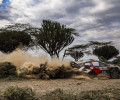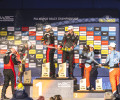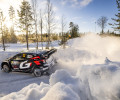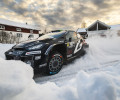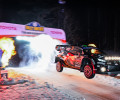WRC - The 2017 World Rally Car - Power to the WRC
Patrice Davesne, Engine Manager at Citroën Racing, explains some of the complexities behind engine development for the all-new C3 WRC that will hit the stages of the FIA World Rally Championship in 2017.

For the fans, the distinctive look of the exciting new-era 2017 World Rally Cars will create a dynamic impact but, underneath the bonnet of these potent-looking cars, engine developments will also boost the sound of these 1.6 litre turbo-charged machines on the stages of the FIA World Rally Championship.
The engine capacity remains the same as the current cars, but while the increase in the diameter of the turbo restrictor from 33mm to 36mm - resulting in an increase of power to 380 bhp - may be the significant modification in the 2017 Technical Regulations, the complexities surrounding this single change are far more multifaceted, as Patrice Davesne, Engine Manager at Citroën Racing takes time to explain.
The team has a long and illustrious history in both cross country and sprint rallying and since its debut in the FIA World Rally Championship in 2000, Citroën has won the Manufacturers’ Championship on eight occasions, those accolades sitting alongside nine consecutive Drivers’ and Co-drivers’ titles. With a WRC history spanning 16 years, Citroën Racing will also have drawn on the experience and knowledge acquired from running the WRC’s new engine with a similar power level and lifespan in the WTCC for the last three years, providing a beneficial platform to re-launch its assault on the series after a year of development.
What is different between the engines in WRC cars in 2016 compared with the new cars being introduced in 2017?
Patrice Davesne:
“Concerning the FIA rules, the sole difference is the inlet turbo restrictor. It was 33mm and it becomes 36mm, which means about 20% air flow increase. In consequence we need to change the turbo charger because the compressor side is not large enough and we need to develop a new one to adapt to this new flow.”
Is Citroën designing a new engine for the WRC, knowing that a new three-year homologation cycle starts with the introduction of the new technical regulations in 2017?
Patrice Davesne:
“Yes, absolutely, we develop a fully new engine. We decided to change the bore, it was 82mm since the beginning of our time in WRC and now we decide to increase the bore diameter and we are now at the limit allowed by the FIA which is 84mm. Also, due to the increase of the flow and the diameter of the restrictor, we need to manage very carefully the ‘knock’ and we need to develop a completely new system. It takes a lot of work on the dyno, it was a very large job and we have arrived to a good system that avoids any overcharge of combustion pressure and that’s very important for durability of the engine. We also develop some internal system to reduce friction and of course to increase global efficiency of the engine.”
How do you start going about developing an engine for such diverse conditions over a whole Championship season? Do you have simulation equipment where you can recreate conditions?
Patrice Davesne:
“We are very lucky to have great experience in WRC events so for each problem we have met in the past we have developed a process and adapted our dyno to solve these. So now when we develop a new engine we have many many processes that we use on the dyno to avoid any problem we have already met in the past. Also we are lucky to have a very good dyno that is able to simulate conditions; we can run on the dyno a stage anywhere in the world, except perhaps Sweden. But for example, Mexico, we can simulate altitude with our dyno and it’s a real advantage.”
What evolutions will be permitted on the engine throughout the season?
Patrice Davesne:
“We can make changes, but some parts of the engine are frozen by the regulations for three years. For example, bore is not allowed to change, the distance between cylinder and distance between camshaft we can’t change. But we have three jokers per year and, for example, we can change in the same year the pistons, connecting rods and oil sump. Each year there are three jokers and we can use them as we want – it can be development, increase our power or durability, it’s as we want.”
What will be the difference in regard to torque and power with the new engines; and will this make a difference in the way the cars are driven?
Patrice Davesne:
“Concerning the torque on the new engine, there is no evolution. Concerning the FIA regulations we have two constraints; one is the restrictor on the inlet compressor, the second one is the limit of pressure in the inlet manifold. It is not allowed to overpass 2.5 bar so as this regulation remains the same, the torque remains the same. The change of the new engine is only power. With the new restrictor we have more power at higher revs. Concerning the driveability - the feeling of the drivers - it depends on the configuration of the road. If the stage is quick, like in Finland, they said it’s an evolution but not a revolution. On the tricky roads, the increase of the power creates greater acceleration and the feeling of the drivers is ‘wow, it’s another world’.”
Did you have to design a new transmission because of the extra power and torque?
Patrice Davesne:
“I am not in charge of transmission, but I can say yes, we have developed a new transmission which takes into account the new power of the engine.”
What will the fans get from these new engines and cars?
Patrice Davesne:
“It’s difficult to say what fans will say because it depends on the feeling you have mainly with noise. With the new engine we have much power at higher revs and that means much noise, and the feeling when you watch the car is much more noise. Also the car with the new regulations is larger, so if the car is larger you need more horsepowers to have a big impression.”
See the design and development work behind the C3 WRC engine below:

 Facebook
Facebook Twitter
Twitter